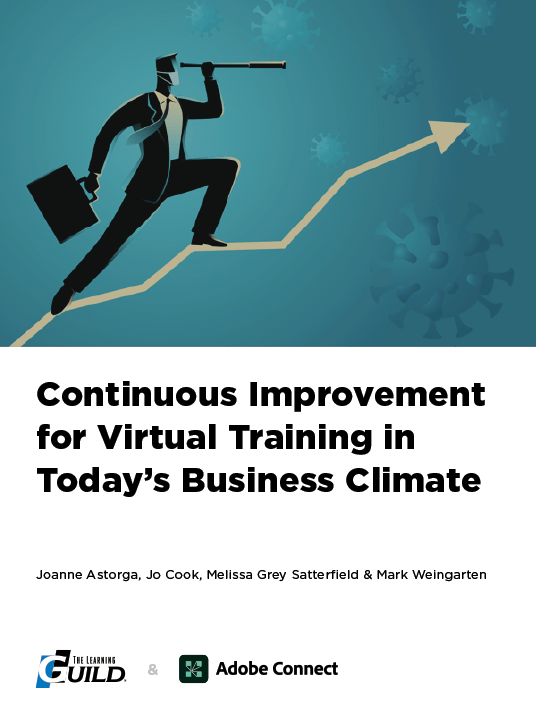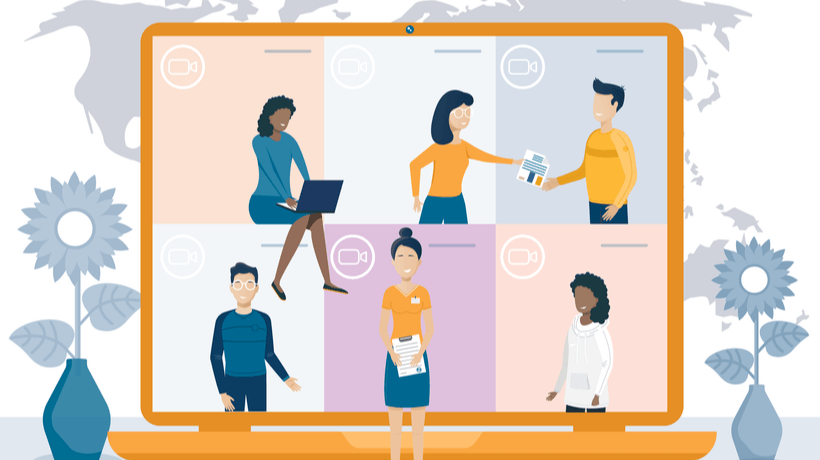Case Study: How A Hybrid VILT Model Helped One Company Rise To "New Normal" Challenges
Everyone would agree that 2020 was an unprecedented year for learning and development. Although companies might have dabbled in virtual training prior to COVID-19, the pandemic forced global organizations worldwide to dive in headfirst. One of the main factors driving the explosion of interest in virtual training in 2020 was the number of employees working from home. While no one can predict the future, virtual training is projected to continue to grow post-pandemic, as organizations have discovered its benefits and reaped the cost savings of the model.

Four Experts Weigh In
L&D professionals who turned to virtual training in 2020 out of necessity want to know how to best leverage it moving forward. What follows are four thought-provoking essays with practical suggestions and best practices for continuous improvement in virtual training, as well as extensive resources for learning professionals who want to dive deeper.
In the eBook, Continuous Improvement For Virtual Training In Today's Business Climate, four global L&D trailblazers discuss how the COVID-19 crisis influenced their training
approaches in 2020; how they organizationally adapted to the challenges of delivering learning in a volatile business climate; and which of these adaptations they believe will be here for good and why. They also share their predictions for the future of training in 2021 and beyond. This is the first story in our series, provided by Joanne Astorga, Chief LX Specialist for GEVC.
Adapting To An Accelerated Development Schedule
I work for a small eLearning company in Ottawa, Canada; our client roster includes government departments, national associations, private companies, not-for-profit organizations, and post secondary institutions. Before the pandemic, most of our clients conducted the majority of their training in a classroom, although 90% of our business has always been converting instructor-led training and policies and procedures to an online, asynchronous format.
Impact of the COVID-19 crisis
In March 2020, we experienced two converse challenges: a slowdown with large organizations, and a warp-speed acceleration with post-secondary institutions. When government departments and national associations moved much of their workforce (including L&D teams) to a work-from-home model, the training projects we had been working on with them slowed to a crawl due to lack of IT and collaboration infrastructure. For the first few months until early summer 2020, many of our clients had neither reliable VPN access to their organization’s servers, nor robust collaboration and/or communication software in place. As a result, many of our projects came to a temporary standstill. Unable to predict when the pandemic would stabilize, organizations froze their non-essential spending budgets, and as is often the case, drew from their L&D budgets to pay for other urgent expenditures.
With one post-secondary institution we are working with, however, the opposite was true. To continue to serve its students (especially its international student population since borders were quickly closed, barring students from coming to North America to attend their classes), it was crucial to adapt face-to-face instructor-led courses to a virtual and online format in time for the spring-summer semester. Our “warp speed” project saw us converting seven 40+-hour courses to an online, asynchronous format in just over eight weeks. That meant writing and developing more than 280 hours in 40 days, which works out to creating seven hours of training per day. If you’ve ever researched the ratio of development to training time, you’ll know that it usually takes much, much more time than that to create effective online learning
Meeting The Challenges Of A “New Normal”
How did we adapt to such an accelerated development schedule? By relying more heavily on three things we have always done. The first was to separate the instructional design role from the graphic design and development role, because specialists can complete their specific tasks faster and more effectively than generalists. The second was to incorporate Dr. Will Thalheimer’s Science of Presentation ELRA model, which reminds us to: Engage learners from the outset; help them Learn with well organized information; build in opportunities to help them Remember; and motivate learners to Act on their new knowledge. The third was to improve processes on the fly, agreeing to try new ways of doing things quickly for the sake of better outcomes. Speaking of better outcomes, most of the instructors we worked with in those early months were deeply concerned about the effectiveness of pivoting to VILT.
Their palpable trepidation stemmed from uncertainty about their roles, given that in the hybrid VILT model the institution adopted, content was moved online with instructors offering shorter, scheduled VILT sessions each week. “What will I be doing while students are reading the content?” and “What will they need me for if they already have the course content?” were two common questions.
The Flipped Approach
We answered those questions as we always have ... by “flipping” classrooms to allow learners to view (and re-view) content at their own pace before virtual instructor-led sessions, the nature and quality of those VILT sessions improves for all. Students can review content at their own pace, using accessibility features like screen readers if they wish, as many times as they wish. Instructors, for their part, are no longer relegated to explaining and repeating facts, figures, theories, principles, frameworks, and models, but can focus on providing more detailed examples, recounting more complex case studies, and discussing more nuanced questions from students who have had time to digest and synthesize the content.
I also remind folks that people read twice as fast as anyone can speak, so it’s always been a more efficient use of everyone’s time to use VILT for interaction and engagement rather than rote learning, especially during a pandemic when everyone is carrying an extra load and work days are fuller than ever as workplaces adapt to a constantly changing “new normal”.
Learners value our VILT model
We’ve had feedback from learners that they were pleasantly surprised at how engaging and effective a hybrid VILT model was. Students appreciated short introductory videos by their instructors, which help set the tone and context for the information that followed. Students learning in English as a second language appreciated being able to read and re-read online content as many times as they wished, and to use a screen reader to help them with pronunciation. All students looked forward to meeting their instructor and classmates in VILT sessions, which, when repeated regularly, helped build a sense of comradery and community, which they had not expected.
Vision For The Future
Just as the pandemic has revealed fault lines in our societies, it has also reminded us of truths we’ve taken for granted—like the need for human connection, the power of a unique voice, the difference even small kindnesses can make, and the fact that any L&D technology, be it a learning management system, courseware authoring tool, or virtual training platform, is only as effective as the humans using it. We need to invest in employees, which includes upskilling our L&D specialists, training our trainers, expanding our L&D teams to include more specialists in instructional design, graphic design, UX and accessibility, and courseware development.
I envision an L&D industry that finally recognizes the value of instructional design and presentation skills, looks for those skills in new L&D members, and shares those skills as widely as possible so that people shift from uttering “Uuggghhhh, I have to take another online training session” to “Can’t wait for that online session. They’re so engaging and thought-provoking!”
I also predict that more corporate organizations will begin adapting a more varied model for their virtual training whereby learners have access to a combination of short, pre-recorded videos by well-spoken experts, well-written online content and job aids, and focused, virtual instructor-led sessions where learners can ask questions or concentrate on more technical details, complex concepts, or question-and-answer sessions. After all, it’s a model that’s been working brilliantly for massive open online courses (MOOCs) for many years now, for good reason.
Virtual Training For Continuous Improvement To Adapt And Evolve
Finally, with such a massive uptake on VILT, I fully expect more organizations to offer train-the-trainer sessions for subject matter experts. Again, we’ve always known that SMEs aren’t necessarily skilled public speakers or trainers (although some are, of course), just as we know that instructional design and public speaking can be taught, learned, and practiced for better organizational and individual results.
Download the eBook Continuous Improvement For Virtual Training In Today's Business Climate to learn how L&D thought leaders overcame COVID challenges and what they see for the future of online training.
References
Presentation Science Workshop — First Graduations





![Continuous Improvement For Virtual Training In Today's Business Climate [eBook]](https://cdn.elearningindustry.com/wp-content/uploads/2021/04/shutterstock_1108236824.png)



